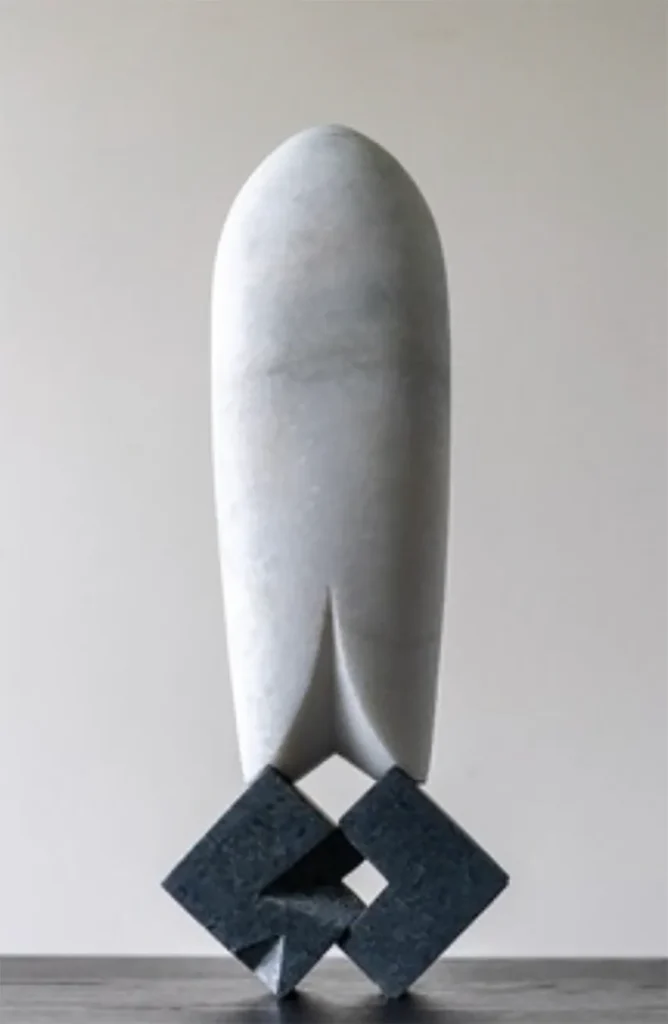"Sculpture NOW" at McLean Project for the Arts
By Mark Jenkins, Published in Discerning Eye Oct 19, 2024
VARIETY IS KEY, both throughout the show and within individual works, in McLean Project for the Arts's "Sculpture NOW." The impressive array includes pieces that echo the sleek formalism and sturdy materials of 20th-century abstract sculpture. More common, however, are funky assemblages, delicate ingredients, and artworks that hint at narrative. One intriguing motif is an element that appears to be emerging from the whole, intentionally disrupting the sculpture's overall unity.
Juried by MPA Curator and Artistic Director Nancy Sausser from work submitted by members of the Washington Sculptors Group, the sweeping exhibition includes the work of nearly 70 participants. Regular visitors to local galleries will recognize certain artists's familiar strategies, and perhaps even specific artworks. The latter are usually worth a second look, though, and the show also offers much that is splendidly unexpected.
Among the more streamlined pieces are one by Lisa Battle in which mirrored stoneware forms partly overlap; an elongated diamond made of burnished and painted mild steel by Gilbert Ugiansky; and Cristian Ianculescu's "Rocket," made of two types of stone and suggesting -- like so many of the show's entries -- an untold story.
Featured are more than a few thin, towering metal structures, all of which take a twist away from the methodical. Frederic Crist's mostly immaculate "Aluminum Totems" turn jagged at their tops, and a human hand crowns the otherwise austere steel rod forged and welded by Mary Frank. Joshua Prince's parallel steel poles, anchored in concrete, make an eccentric sideways jag before jutting upwards. Brian Kirk's red-powder-coated steel spire also is primarily vertical, but with attached asymmetrical outcroppings that jumble its visual momentum. Kenneth Hilker deploys a salvaged metal rod, but interlaces it with jagged vertical columns of burnt wood.
The way that pole partly emerges from a larger entity mirrors the gambits of several other artists. Hair-like fiber bulges from the side of a mulberry-paper pillar in Tatyana Shramko's "Fragile Self I," which is topped by a human head. Equally psychological is Janathel Shaw's painted-stoneware "Looking Beyond the Veil," in which a head stands atop a coffin-like brown body that holds a white skull in its belly. Folded hands protrude from a black soapstone block in Zdeno Mayercak's "Nightfall," and a painting is nestled within the chest of a ragged human figure in Alice Quatrochi's "Emerging from Our Separateness (EFOS)."
Combining incongruous materials, often pitting organic versus manufactured, can inspire thoughts of conflict between humanity and the environment. Adjoa J. Burrowes's "Entangled Earth" uses paper, paint, and branches to abstract nature, while Tom Hill's "Flamethrower" contrasts tree parts with machined lumber. Cora Olson incorporates animal bones into a mysterious ceramic form that suggests, among other possibilities, a dried insect pod or ancient grave goods from an archaeological dig.
Metal, often distressed, is fashioned into organic shapes in Donna Mccullough's statue of dog, recast from an old file cabinet, and Doug Fuller's "Six-Legged Sea Star," made mostly of rusted found objects. Less specific, but evidently nature-inspired, are Marcella Morgese's flower-style steel construction and Larry Currence's "Arthopodic," a curved, shell-like shape made partly of copper.
Among the many contributors who assemble disparate materials are a few who barely assemble at all. Heather Harvey fills a corner of the gallery with found materials from Portugal, physically separate but held together loosely by a painted backdrop. Lori Katz's "Wall of Cubes," unconnected stoneware pieces in various sizes and finishes, could be in the process of cohering or fracturing.
Equally dismantled in form but more unified in theme is one of the show's standouts, Wanjin Kim's "Self-Portrait." The piece comprises 17 hand-fabricated copper blocks, each with a relief sculpture on its outward-facing facet. At the center is a nose, and a few other recognizable body parts revolve around it. But other elements are internal -- fat, pancreas -- or are physical conditions -- headache, osteoporosis -- the artist cunningly visualizes. Kim is the most autobiographical of the show's storytellers, but like the others she distills the tale to a display of intriguing fragments.
Read the Article and subscribe to DisCerning Eye on Substack
